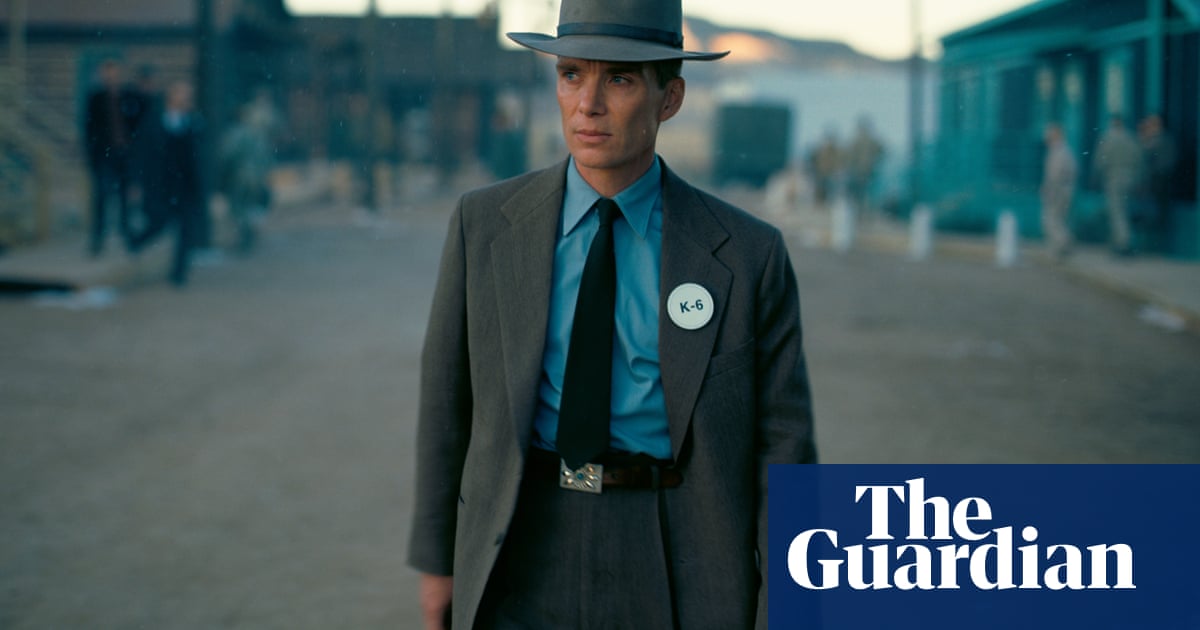
JRobert Oppenheimer’s apocalyptic legacy has haunted modern politics and culture, but his personal story is not obvious blockbuster material. It would take a film-maker of the talent, and Hollywood heft, of Christopher Nolan to pull it off.
Oppenheimer opened in the US last weekend with a box office haul of $82m, second to Barbie’s gargantuan $162m. The instincts of Nolan, and his backers at Universal Studios, have been rewarded in a way that, hopefully, bodes well for the future of big-budget films about difficult subjects (Nolan isn’t the only purveyor of such work, but there aren’t many around).
There isn’t much need for a spoiler alert here. There is a big, impressively shot explosion in the film, although it is far from the denouement of the piece. But there is plenty to discuss, starting with the implications of Oppenheimer’s story for the world. And for that, we need to reveal the film’s last lines.
Albert Einstein and the destroyer of worlds
The film ends with a conversation between the godfather of the nuclear bomb and Albert Einstein in 1947, in which Oppenheimer (Cillian Murphy) reminds the German-born theoretical physicist that he had once approached him about fears that his project would “destroy the entire world”. Einstein, played by Tom Conti, says: “What of it?” To which Oppenheimer replies: “I believe we did.”
It is a devastating moment and is the emotive payload of the film, followed by a montage featuring rows of nuclear missiles, vapour trails of projectiles puncturing the sky, the planet being consumed by fire – and Oppenheimer’s stricken face.
The excellent biography on which the film is based, American Prometheus by Kai Bird and Martin J Sherwin, goes into great detail about Oppenheimer’s regret over, and attempts to rein in, the monster he created. (I should note here that, in real life, Oppenheimer consulted a different physicist, Arthur Compton, about his apocalyptic concerns.) There are obvious parallels with the modern day and artificial intelligence, whose creators are now calling for development of the technology to be tamed.
Nolan told the Guardian that there are “very strong parallels” between Oppenheimer and the AI community. It is worth noting that signatories of a letter calling for a six-month pause in AI development this year included Elon Musk, an initial backer of ChatGPT developer OpenAI, Yoshua Bengio, a winner of the Turing prize (or “Nobel prize for computing”) and the co-founder of Apple, Steve Wozniak. As with Oppenheimer, has the technology community left it too late to address the potential consequences of their achievements?
Cillian Murphy: best man for the job?
Murphy’s leading man credentials are not in doubt, with a résumé that includes Peaky Blinders and critical hits such as Sunshine. His performance in Oppenheimer is even more impressive in the context of the nuanced, assiduous biography by Bird and Sherwin, which portrays an individual as complex as you would expect a high-achieving theoretical physicist to be. If there is one detail Murphy captures in particular, it is Oppenheimer’s soft voice and, of course, their similarity in looks (Murphy, at 47, is broadly the same age as Oppenheimer was, at 41, when the bomb was first tested in 1945).
Other performances feel faithful to the book as well: Matt Damon as the gruff Lt Gen Leslie Groves, the military overseer of the project and a key supporter of the enigmatic Oppenheimer; Emily Blunt as the scientist’s alcoholic wife, Kitty; Robert Downey Jr as Oppenheimer’s vindictive foe, Lewis Strauss, who pursued his target with a zeal that appeared to be based on perceived personal slights rather than any patriotic principle; and Kenneth Branagh as Niels Bohr, the Danish quantum genius who makes a brief appearance as the film’s seer and moral conscience. Einstein was ambivalent about Oppenheimer’s theoretical work and, as played by Conti, he is an enigmatic figure in the film at least.
Too tasteful?
The film shows the first ever nuclear explosion in an impressively staged sequence but does not show what followed: the weapon’s use on civilian targets in Hiroshima and Nagasaki. This drew criticism from one nuclear campaigner, who told the Guardian that the result was an “unbalanced” film, with the impact of the Japan blasts instead portrayed by a quasi-nightmare sequence where Oppenheimer is beset by disturbing visions in a supposedly triumphal speech to Manhattan Project workers in Los Alamos.
“The effect of the [Hiroshima and Nagasaki] blasts was to remove the skin in a much more gory and horrible way – in the film it was tastefully, artfully presented. There’s nothing wrong with that, but if you look at photographs of actual survivors and read accounts of what happened to them it was a very horrifying, gory death,” said Carol Turner, a co-chair of the Campaign for Nuclear Disarmament’s London branch.
Nolan says he felt that “to depart from Oppenheimer’s experience would betray the terms of the storytelling” and Oppenheimer is very clear about its focus on the protagonist, hence a final act that largely dwells on Strauss’s successful attempt to sully the scientist’s reputation by having his security clearance removed.
Sanskrit sex
Nolan has been criticised for the representation of female characters in his previous films and Oppenheimer has drawn similar comments. One scene between Oppenheimer and Jean Tatlock, his former partner and then lover, played by Florence Pugh, has been criticised by India’s information commissioner because it features Oppenheimer reciting a passage from the Bhagavad Gita (a favourite text of Oppenheimer’s) mid-intercourse. Murphy has said the scene is “not gratuitous” and is “powerful”. Blunt’s Kitty, a trained botanist, has pivotal scenes – particularly during his security clearance hearing – but male scientists dominate the film (as they dominated the Manhattan Project itself).
Is Nolan getting enough bang for his buck?
The explosive centrepiece of Oppenheimer eschews digital visual effects and instead recreates the Trinity test via analogue tricks such as camera perspective and a lot of petrol, propane and magnesium flares. The other old-fashioned aspect of the film, and an undeniable positive, is that it is an unapologetic talkie. Which is what the subject matter deserves.












